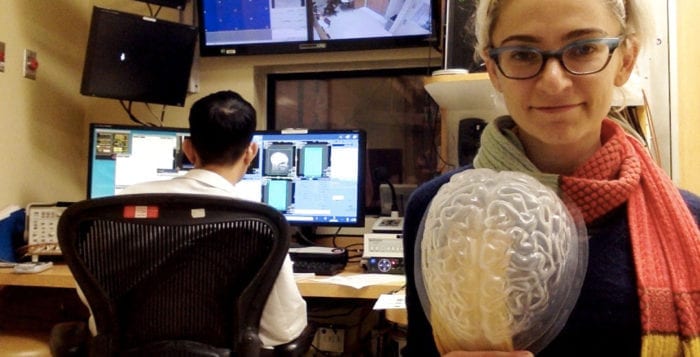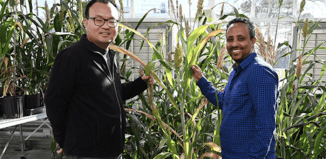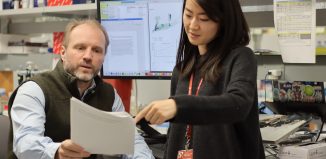Stony Brook’s Johanna Jarcho peers into the minds of anxious adolescents
Ever stare at the head of an anxious adolescent — wait, is that a redundant phrase? — and wonder, “What’s going on inside that head?” While Johanna Jarcho can’t read their minds, she can see areas of the brain that are active during different simulated social situations using a functional-MRI brain scan.
Through her work, she found some areas of the brain are more active, or light up, with children who are isolated or feel socially withdrawn, compared with the same areas of children who are more socially comfortable.
“The goal is to identify what is it about certain kids that are at risk that makes them resilient and what it is about those that develop the symptoms” of anxiety disorders, said Jarcho, who is an assistant professor of psychology at Stony Brook University, with joint appointments in the clinical area as well as the social and health areas. “If we can identify those kids who might be at risk, we can specifically target treatments for them,” she said.
Jarcho, who was part of a study that followed the same group of children from the time they were 2 until they were 11, published her research in the journal Psychological Science. She participated in this ongoing effort for the last four years. “One of the amazing thing about having this long-term data is that we’re still following these kids,” she said. “They are being evaluated now.” The children participating in the study are now 14.

Understanding any signature activity in the brain could help with diagnosis, treatment or prevention of anxiety disorders, Jarcho said.
Adolescence is rife with the kind of stresses that can create long-term anxieties. “Social anxiety disorder in particular has a very specific developmental trajectory,” Jarcho said. “If you don’t develop it by the time you’re in your early 20s, your probability of developing it is low.” She said 80 to 90 percent of those who experience social anxiety disorder develop it when they’re adolescents.
Typical clinical measures, including self-reports from adolescents, aren’t good predictors for the development of anxiety disorders said Jarcho, who along with a host of scientists are using other biological measures, like MRI scans, in connection with clinical observations.
Collaborators applauded Jarcho’s efforts and see clinical potential down the road from this type of study. “These findings definitely contribute to our understanding of the etiology of anxiety disorders,” Amanda Guyer, an associate professor in the Department of Human Ecology at the University of California, Davis, explained in an email. “This type of longitudinal work is critical to moving the field forward in understanding the etiology of disorders as they unfold over time” for some adolescents.
Gathering information about anxiety and social interactions while children are in MRI machines required some creativity. The children are on their backs, laying perfectly still in a dark, metal tube, which aren’t conditions conducive to social interactions.
Tapping into the next generation’s comfort with modern technology, Jarcho and her colleagues asked the children to create their own avatar, a cartoon version of themselves. While they are in the machine that monitors their minds, their avatars go through a range of social interactions.
“This is one of the first studies where we were able to utilize a lot of different social nuances that we experience,” Jarcho said. “Using this, we are able to bring a good slice of the social world into this constrained environment.”
These kinds of studies are in the early stages of development, said Jarcho, who made an avatar of herself. Researchers are using the latest technology to gather new insights about what patterns might lead to a range of longer-term emotional outcomes.
Numerous factors contribute to the mental health of developing children, Jarcho said, which could make the interpretation or predictive value of any biological information difficult.“You have to collect a huge amount of data to identify complex patterns to make these meaningful clinical classifications,” she said, including the type of parenting a child receives.
In the bigger picture, Jarcho is interested in understanding the mechanisms associated with having positive social interactions. She said she would like to know how neurobiology of normal social competence develops and what contributes to deficits in social competence.

Jarcho, who joined Stony Brook last August, is also interested in pursuing other research goals, including determining what other people are picking up from someone who has a clinical disorder. She wants to find the subtle signals that people use to interpret someone else’s behavior. She has tracked the eye movements of people observing others with clinical diagnoses to determine if there was something the socially anxious person was doing that signals an anxiety.
Jarcho has added a few undergraduates to her lab and plans to start working with her first graduate student in August.
Guyer, who has known Jarcho for five years and collaborated with her on writing research papers and grants, highlighted Jarcho’s dedication.
“She cares deeply about conducting rigorous research that can have a positive impact on youth,” Guyer said.
Jarcho and her husband Charles Best live in Port Jefferson with their rescue dog Tosh. A mathematician and software developer who was a researcher at Apple, Best is working with Jarcho on a startup effort called RSRCHR, which will provide neuroimaging researchers with a cloud-based platform to help maintain an infrastructure for fMRI data storage, management and analysis.
They have a prototype Jarcho uses and are seeking funding to support their work.
Starting in September, Jarcho plans to collaborate with Stony Brook Psychology Professor Greg Hajcak to look for a neural signature on how children react to their own errors. These signatures may suggest an increased risk for anxiety.
Jarcho said she feels comfortable at Stony Brook. “The longer I’m at Stony Brook, the more I realize what a truly unique place it is,” she said. “The faculty in the Psychology Department has a tremendous interest and willingness to collaborate.”







